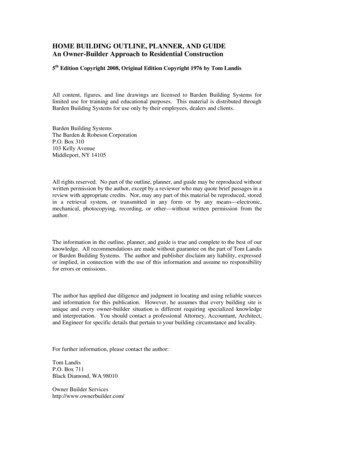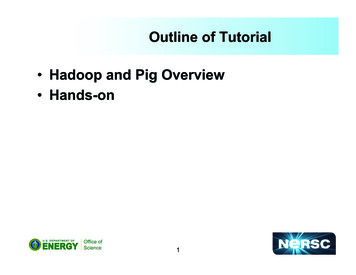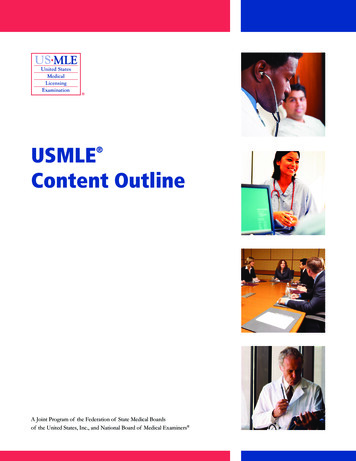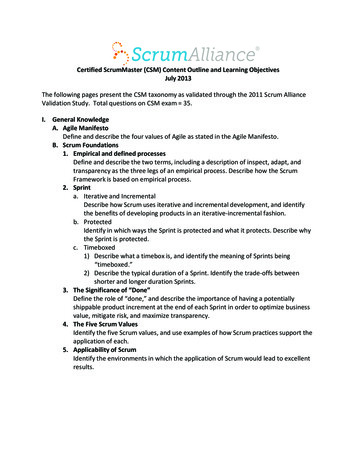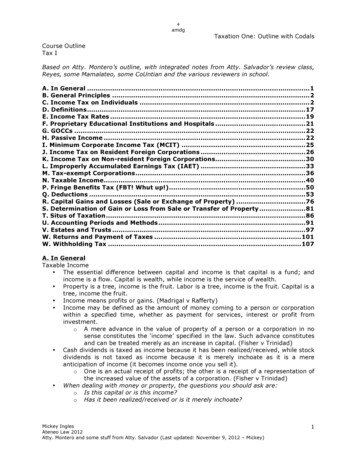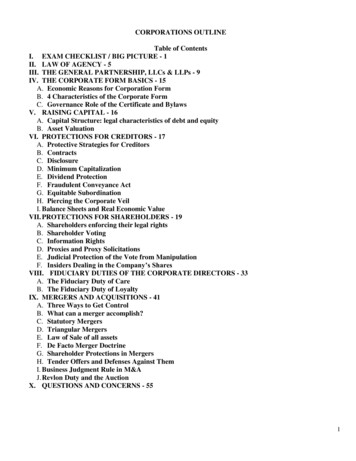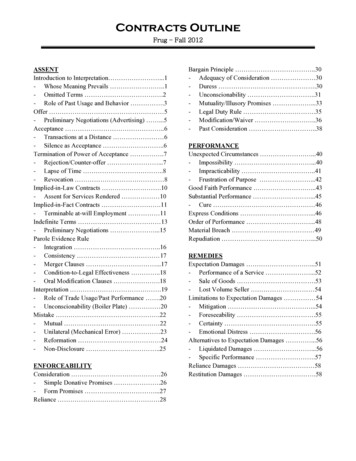
Transcription
SCHAUM’S OUTLINE OFTHEORY AND PROBLEMSOFHEAT TRANSFERSecond EditionDONALD R. PITTS, Ph.D.Professor Emeritus of Mechanical and Aerospace Engineering and Engineering ScienceThe University of Tennesse - KnoxvilleLEIGHTON E, SISSOM, Ph.D., P.E.Dean Emeritus of Engineering‘Tennessee Technological Universit4, - CookevilleSCHAUM’S OUTLINE SERIESMcGRAW-HILLNew York San Francisco Washington, D.C. Auckland Bogotlf Caracas LisbonLondon Madrid Mexico City Milan Montreal New DelhiSan Juan Singapore Sydney Tokyo Toronto
Dr. DONALD R. PITTS holds three engineering degrees- the B.M.E.from Auburn University, the M.S.M.E., and Ph.D. from the GeorgiaInstitute of Technology. His 27 years of academic experiences includeappointments at Tennessee Technological University, Clemson University,and the University of Tennessee-Knoxville. All of his universityassignments have been in teaching and research in the Thermal Sciences(Thermodynamics, Fluid Mechanics, and Heat Transfer). These experiences include one year as a Program Manager at NSF and one year asDirector, Tennessee Energy Extension Service. Dr. Pitts has coauthoredone major textbook and one Schaum’s Outline, both in the heattransfer/fluid mechanics area. H e has authored or coauthored 20 refereedresearch papers and major reports, and he is thoroughly qualified to writeon the topic of Heat Transfer.Dr. LEIGHTON E. SISSOM is a registered professional engineer. Heholds four degrees, including a B.S.M.E. from Tennessee TechnologicalUniversity and M.S.M.E. and Ph.D. from the Georgia Institute of Technology. He has served as a consultant to over 600 organizations in 41 statesand 11 foreign countries. H e has written many papers and proprietaryreports, and has coauthored four books including one textbook and oneSchaum’s Outline. His 30 years in academe have been focused on teachingand research in the thermal sciences (Thermal Dynamics, Fluid Mechanics,and Heat Transfer). Dr. Sissom is highly qualified to write on the subjectof Heat Transfer.Schaum’s Outline of ‘Theory and Problems ofHEAT TRANSFERCopyright 0 1998, 1977 by The McGraw-Hill Companies, Inc. All rights reserved. Printed inthe United States of America. Except as permitted under the Copyright Act of 1976, no partof this publication may be reproduced or distributed in any forms or by any means, or storedin a data base or retrieval system, without the prior written permission of the publisher.2 3 4 5 6 7 8 ‘1 I 0 1 1 12 I3 14 15 I6 17 I X 19 20 PRS PRS 9 0 2 1 0 9I SB N 0-07-050207-2Sponsoring Editor: Barbara GilsonProduction Supervisor: Sherri SouffranceEditing Supervisor: Maureen B. WalkerProject Supervision: Keyword Publishing Services LtdLibrary of Congress Cataloging-in-Publication DataPitts, Donald R.Schaum’s outline of heat transfer / Donald R. Pitts, Leighton E. Sissom. - 2nd ed.p. cm. - (Schaum’s outline series)Originally published: Schaum’s outline of theory and problems of heat transfer.New York : McGraw-Hill, cl997.Includes index.ISBN 0-07-OSO207-2 (pbk.)1. Heat -Transmission. 2. Heat -Transmission - Problems, exercises, etc.I. Pitts, Donald K.,Schaum’s outline of theory and problems of heat transfer.11. Sissom, Leighton E. 111. Title. IV. Series.QC32O.PSS 1988621.402‘2-dc2 198-2 1008CI PMcGraw-HillA Division of 7keMcGtuw.Hill Companiesi?
PrefaceLike the first edition, as well as all of the Schaum’s Series books, this secondedition of Heat Transfer is intended to function as (1) an independent, self-teachingtext and/or (2) a supplemental aid for students taking a college course in heattransfer at the junior or senior level. To fulfil1 these dual roles, there are severalfactors that must be considered. One of these is the long-standing argument overthe nature of treatment, that is, mathematical derivations of the thermal transportrate equations or collections and applications of empirical equations. Again, as inthe first edition, we believe we have achieved a useful compromise between thesetwo approaches.Another major factor is the choice of a unit system. The unit system must becompatible with that in current college textbooks on this subject. Many, if not most,heat transfer texts are using the Systkme International d’Unit6s (SI unit system)exclusively. The ASME has required that all publications of the Society since July1, 1974, must be in SI units. However, the slow transition from the English systemof units decrees that most students currently studying heat transfer will need to befamiliar with both SI and English units for many more years. In this book we have208 solved problems having units and 63 solved problems with no units. Thepercentage split between SI and English units is approximately 75/25 whereas thefirst edition had approximately 60/40 English/SI problems. But we have includedenough English unit system solved problems to satisfy the needs of students andprofessionals using English units only or those needing a dual system experience.In support of this need a very useful approach to obtaining property values hasbeen incorporated. Basically, we have included rather complete tables for both SIand English units. The English tables continue to feature conversion factors at thebottom of each page.While the field of heat transfer is constantly growing in useful knowledge, wehave intentionally emphasized the more traditional and familiar approaches toeach of the major subtopics of this subject. In many areas, we note that newerempirical correlations yield very nearly the same results as do the older ones. Wehave utilized simpler approaches wherever suitable.As in the first edition we have continued the approach where each chapterbegins with a statement of the class of heat transfer, or related topics to beconsidered. This is followed by abbreviated textual treatment@), mathematicaland/or empirical. Then the focus turns quickly to the Solved Problems which arethe very essence of the presentation. Note that “related topics” include FluidMechanics-Chapter 5. Although not in most heat transfer texts, this book will beused by many persons with no background in Fluid Mechanics. This subject is veryimportant, indeed, essential to understanding the material in Chapters 6, 7, and 8,and to a lesser extent, Chapter 10.In summary, for each chapter we (i) present a concise textual treatment of amajor subtopic emphasizing theory, analyses and empiricism important to thatsubject, (ii) provide an extensive set of Solved Problems, practical and theoretical,including a mixture of unit systems with unit inclusion in many problems, andfinally (iii) include a set of unworked, Supplementary Problems (usually withanswers) to enhance opportunities for self evaluation.111
ivPREFACEWe believe that this second edition meets the changing needs for a selfteaching text for working professionals and students in this field and the need fora supplemental aid for junior- and senior-year college students. We wish every usera fulfilling experience in study from this book.We wish to express our appreciation of the efforts of Ms. Mary Loebig Gilesof McGraw-Hill for her continued support of this project, and to Ms. JanineJennings who typed the manuscript.DONALDR.PI-ITSKnoxville, TNLEIGHTONE. SISSOMCookeville, TN
ContentsChapter 1Chapter 2INTRODUCTION .1.1 Conduction .1.2 Convection .1.3 Radiation .1.4 Material Properties .1.5 Units .0N E.D IMENS I 0NA L STE A DY-STATE C0ND U CTI0N .Introductory Remarks .General Conductive Energy Equation .Plane Wall: Fixed Surface Temperatures .Radial Systems: Fixed Surface Temperatures .2.12.22.32.42.52.62.72.8Chapter 3Chapter 4Plane Wall: Variable Thermal Conductivity .Heat Generation Systems .Convective Boundary Conditions .Heat Transfer from Fins .1225161616181920202225MULTIDIMENSIONAL STEADY-STATE CONDUCTION .Introduction .Analytical Solutions .Conductive Shape Factor .Numerical Analysis .5656565961TIME-VARYING CONDUCTION .Introduction .Biot and Fourier Moduli .Lumped Analysis .One-Dimensional Systems: Fixed Surface Temperature .One-Dimensional Systems: Convective Boundary Conditions .Chart Solutions: Convective Boundary Conditions .Multidimensional Systems .Numerical Analysis .8787878889919298FLUID MECHANICS .5.15.25.35.45.5Chapter 6i3.13.23.33.44.14.24.34.44.54.64.74.8Chapter 51Fluid Statics .Fluid Dynamics .Conservation of Mass .Equation of Motion Along a Streamline .Conservation of Energy .99123123124127128129FORCED CONVECTION: LAMINAR FLOW .1446.1 Hydrodynamic (Isothermal) Boundary Layer: Flat Plate .144V
CONTENTSvi6.26.36.46.5 Chapter7Thermal Boundary Layer: Flat Plate .Isothermal Pipe Flow .Heat Transfer in Pipe Flow .Summary of Temperatures for Property Evaluations . FORCED CONVECTION: TURBULENT FLOW .Equations of Motion .Heat Transfer and Skin Friction: Reynolds’ Analogy .Flow over a Flat Plate .Flow in Pipes .7.17.27.37.47.57.6149151154157External Flow over Submerged Bodies .Heat Transfer to Liquid Metals .184184187187190195200 Chapter 8NATURAL CONVECTION .Vertical Flat Plate .Empirical Correlations: Isothermal Surfaces .Free Convection in Enclosed Spaces .Mixed Free and Forced Convection .8.18.28.38.48.5Newer Correlations .221221226227231232 Chapter9BOILING AND CONDENSATION .Boiling Phenomena .9.19.29.39.4 Chapter 10Pool Boiling .Flow (Convection) Boiling .Condensation . Appendix A245246249251 HEAT EXCHANGERS .10.1 Types of Heat Exchanger .10.2 Heat Transfer Calculations .10.3 Heat Exchanger Effectiveness (NTU Method) .10.4 Fouling Factors .Chapter 11245RADIATION .11.1 Introduction .11.2 Properties and Definitions .11.3 Blackbody Radiation .11.4 Real Surfaces and the Gray Body .11.5 Radiant Exchange: Black Surfaces .26826827027427511.6 Radiant Exchange: Gray Surf aces .11.7 Radiation Shielding .11.8 Radiation Involving Gases and Vapors .289289289291293296303307309.328Table A.1 . Conversion Factors for Single Terms .Table A-2 . Conversion Factors for Compound Terms .328329
CONTENTSAppendixBvii.331Figure B.1 . Dynamic (Absolute) Viscosity of Liquids .Figure B.2 . Kinematic Viscosity of Liquids .Figure B.3 . Ratio of Steam Thermal Conductivity k to the Value k l , at OneAtmosphere and the Same Pressure .Figure B.4 . Generalized Correlation Chart of the Dynamic Viscosity ofGases at High Pressures .Table B-1 (SI). Property Values of Metals .Table B-2 (SI). Property Values of Nonmetals .Table B-3 (SI). Property Values of Liquids in a Saturated State.Table B-4 (SI) . Property Values of Gases at Atmospheric Pressure .Table B-1 (Engl.). Property Values of Metals .Table B-2 (Engl.). Property Values of Nonmetals .Table B-3 (Engl.). Property Values of Liquids in a Saturated State .Table B-4 (Engl.). Property Values of Gases at Atmospheric Pressure .Table B-5 (Engl.). Critical Constants and Molecular Weights of Gases .331332334335338341344347350352356360INDEX .361333
Chapter 1IntroductionThe engineering area frequently referred to as thermal science includes thermodynamics and heattransfer. The role of heat transfer is to supplement thermodynamic analyses, which consider onlysystems in equilibrium, with additional laws that allow prediction of time rates of energy transfer.These supplemental laws are based upon the three fundamental modes of heat transfer, namelyconduction, convection, and radiation.1.1 CONDUCTIONA temperature gradient within a homogeneous substance results in an energy transfer rate withinthe medium which can be calculated bywhere aT/dn is the temperature gradient in the directionnormal to the area A . The thermal conductivity k is anexperimental constant for the medium involved, and it maydepend upon other properties, such as temperature andpressure, as discussed in Section 1.4. The units of k areW/m.K or Btu/h.ft."F. (For units systems, see Section 1.5.)The minus sign in Fourier's law, ( I . ] ) , is required by thesecond law of thermodynamics: thermal energy transferresulting from a thermal gradient must be from a warmer toa colder region.If the temperature profile within the medium is linear(Fig. 1-1), it is permissible to replace the temperaturegradient (partial derivative) withAT- Ax--XFig. 1-1T2- Ti&-XISuch linearity always exists in a homogeneous medium of fixed k during steady state heat transfer.Steady state transfer occurs whenever the temperature at every point within the body, includingthe surfaces, is independent of time. If the temperature changes with time, energy is either being storedin or removed from the body. This storage rate iswhere the mass rn is the product of volume V and density p.1.2 CONVECTIONWhenever a solid body is exposed to a moving fluid having a temperature different from that ofthe body, energy is carried or convected from or to the body by the fluid.
INTRODUCTION2[CHAP. 1If the upstream temperature of the fluid is T, and the surface temperature of the solid is T,, theheat transfer per unit time is given byq hA(T, - T,)(1.4)which is known as Newton's law of cooling. This equation defines the convective heat transfer coefficienth as the constant of proportionality relating the heat transfer per unit time and unit area to the overalltemperature difference. The units of h are W/m2-Kor Btu/h.ft2."E It is important to keep in mind thatthe fundamental energy exchange at a solid-fluid boundary is by conduction, and that this energy isthen convected away by the fluid flow. By comparison of (2.2) and (1.4), we obtain, for y n,hA(Ts- T*) - kA(3where the subscript on the temperature gradient indicates evaluation in the fluid at the surface.1.3 RADIATIONThe third mode of heat transmission is due to electromagnetic wave propagation, which can occurin a total vacuum as well as in a medium. Experimental evidence indicates that radiant heat transferis proportional to the fourth power of the absolute temperature, whereas conduction and convectionare proportional to a linear temperature difference. The fundamental Stefan-Boltzmann law isq oAT4(1.6)where T is the absolute temperature. The constant o is independent of surface, medium, andtemperature; its value is 5.6697 X 10-' W/m2.K4or 0.1714 X 10-8 Btu/h.ft2-"R4.The ideal emitter, or blackbody, is one which gives off radiant energy according to (1.6). All othersurfaces emit somewhat less than this amount, and the thermal emission from many surfaces (graybodies) can be well represented bywhereE,q eo-AT4the emissivity of the surface, ranges from zero to one.(1.7)1.4 MATERIAL PROPERTIESThermal Conductivity of SolidsThermal conductivities of numerous pure metals and alloys are given in Tables B-1 (SI) and B-1(Engl.). The thermal conductivity of the solid phase of a metal of known composition is primarilydependent only upon temperature. In general, k for a pure metal decreases with temperature; alloyingelements tend to reverse this trend.The thermal conductivity of a metal can usually be represented over a wide range of temperaturebyk ko(l b 0 C O 2 )(1.8)where 8 T - Trctand k,, is the conductivity at the reference temperature TrePFor many engineeringapplications the range of temperature is relatively small, say a few hundred degrees, andk kO(l 60)(1.9)The thermal conductivity of a nonhomogeneous material is usually markedly dependent upon theapparent bulk density, which is the mass of the substance divided by the total volume occupied. Thistotal volume includes the void volume, such as air pockets within the overall boundaries of the pieceof material. The conductivity also varies with temperature. As a general rule, k for a nonhomogeneous
CHAP. 11INTRODUCTION3material increases both with increasing temperature and increasing apparent bulk density. Tables B-2(SI) and B-2 (Engl.) contain thermal conductivity data for some nonhomogeneous materials.Thermal Conductivity of LiquidsTables B-3 (SI) and B-3 (Engl.) list thermal conductivity data for some liquids of engineeringimportance. For these, k is usually temperature dependent but insensitive to pressure. The data of thistable are for saturation conditions, i.e., the pressure for a given fluid and given temperature is thecorresponding saturation value. Thermal conductivities of most liquids decrease with increasingtemperature. The exception is water, which exhibits increasing k up to about 150 C or 300 F anddecreasing k thereafter. Water has the highest thermal conductivity of all common liquids except theso-called liquid metals.Thermal Conductivity of GasesThe thermal conductivity of a gas increases with increasing temperature, but is essentiallyindependent of pressure for pressures close to atmospheric. Tables B-4 (SI) and B-4 (Engl.) presentk-data for several gases at atmospheric pressure. For high pressure (i.e., pressure of the order of thecritical pressure or greater), the effect of pressure may be significant.Two of the most important gases are air and steam. (No distinction is made between a gas and avapor in this chapter.) For air the atmospheric values listed in Table B-4 (SI) are suitable formost engineering purposes over the ranges: (i) 0 C d T G 1650 C and 1 atm p 6 100 atm; (ii)-75 "Cd T s 0 "C and 1atm 6 p s 10 atm.Thermal conductivity data for steam exhibit a strong pressure dependence. For approximatecalculations the atmospheric data of Tables B-4 (SI) and B-4 (Engl.) may be used together with FigureB-3. For other gases, one must resort to more extensive property tables.DensityDensity is defined as the mass per unit volume. All systems considered in this book will besufficiently large for statistical averages to be meaningful; that is, we will consider only a continuum,which is a region with a continuous distribution of matter. For systems with variable density we definedensity at a point (a specific location) as(1.10)where 6Vc is the smallest volume for which a continuum has meaning.Density data for most solids and liquids are only slightly temperature dependent and are negligiblyinfluenced by pressure up to 100 atm. Density data for solids and liquids are presented in Tables B-1,B-2, and B-3 in both SI and English Engineering units. The density of a gas, however, is stronglydependent upon the pressure as well as upon the temperature. In the absence of specific gas data theatmospheric density of Tables B-4 (SI) and B-4 (Engl.) may be modified by application of the idealgas law:(I.11)P PI(;)The specific volume is the reciprocal of the density,U -1P(1.12)
4INTRODUCTION[CHAP. 1and the specific gravity is the ratio of the density to that of pure water at a temperature of 4 C anda pressure of one atmosphere (760mmHg). Thuss -P(1.13)Pwwhere S is the specific gravity.Specific HeatThe specific heat of a substance is a measure of the variation of its stored energy with temperature.From thermo-dynamics the two important specific heats are:specific heat at constant volume:c,specific heat at constant pressure:c"r7U r7Tdh3-dT(1.14)( I . IS)Here U is the internal energy per unit mass and h is the enthalpy per unit mass. In general, U and hare functions of two variables: temperature and specific volume, and temperature and pressure,respectively. For substances which are incompressible, i.e., solids and liquids, c,, and c , are numericallyequal. For gases, however, the two specific heats are considerably different. The units of c, and cp areJ/kg.K or Btu/lb,."F.For solids, specific heat data are only weakly dependent upon temperature and even less affectedby pressure. It is usually acceptable to use the limited cI, data of Tables B-1 (SI), B-1 (Engl.), B-2 (SI),and B-2 (Engl.), over a fairly wide range of temperatures and pressures.Specific heats of liquids are even less pressure dependent than those of solids, but they aresomewhat temperature influenced. Data for some liquids are presented in Tables B-3 (SI) and B-3(Engl.).Gas specific heat data exhibit a strong temperature dependence. The pressure effect is slight exceptnear the critical state, and the pressure dependence diminishes with increasing temperature. For mostengineering calculations the data of Table B-4 (Engl.) (other than density) can be used for pressuresup to 200 psia, while Table B-4 (SI) is suitable for pressures up to 1.4 X 10' Pa.Thermal DiffusivityA useful combination of terms already considered is the thermal diffusivity a , defined bykcy-(1.1 6 )PCpIt is seen that a is the ratio of the thermal conductivity to the thermal capacity of the material. Its unitsare ft2/h or m2/s. Thermal energy diffuses rapidly through substances with high a and slowly throughthose with low a.Some of the tables of Appendix B, in both SI and English units, list thermal diffusivity data. Notethe strong dependence of a for gases upon both pressure and temperature; these data for gases areonly for atmospheric pressure, and they are only valid for the specified temperature.ViscosityThe simplest flow situation involving a real fluid, i.e., one that has a nonzero viscosity, is laminarflow along a flat wall (Fig. 1-2). In this model, fluid layers slide parallel to one another, the molecularlayer adjacent to the wall being stationary. The next layer out from the wall slides along this stationarylayer, and its motion is impeded or slowed because of the frictional shear between these layers.
CHAP. 115INTRODUCTIONContinuing outward, a distance is reached where theretardation of the fluid due to the presence of the wall isno longer evident.Consider plane P-P. The fluid layer immediatelybelow this plane has velocity U - 6u, and the fluid layerimmediately above has velocity U Su. Here U is thevalue of the velocity in the x-direction at the y-locationof the P-P plane. The difference in velocity betweenthese two adjacent fluid layers produces a shear stress 7.Newton postulated that this stress is directly proportionalto the velocity gradient normal to the plane:dur pf-dYFig. 1-2(1.I7)The coefficient of proportionality is called the coeficient of dynamic viscosity, or more simply thedynamic or absolute viscosity.Viscosity units As shown by (I.17), the units of pf are N d m 2 or lbf.s/ft2. In many applications it isconvenient to have the dynamic viscosity expressed in terms of a mass, rather than a force, unit. In thisbook, pmwill denote the mass-based viscosity coefficient. In the SI sys
reports, and has coauthored four books including one textbook and one Schaum’s Outline. His 30 years in academe have been focused on teaching and research in the thermal sciences (Thermal Dynamics, Fluid Mechanics, and Heat Transfer). Dr. Sissom is h



